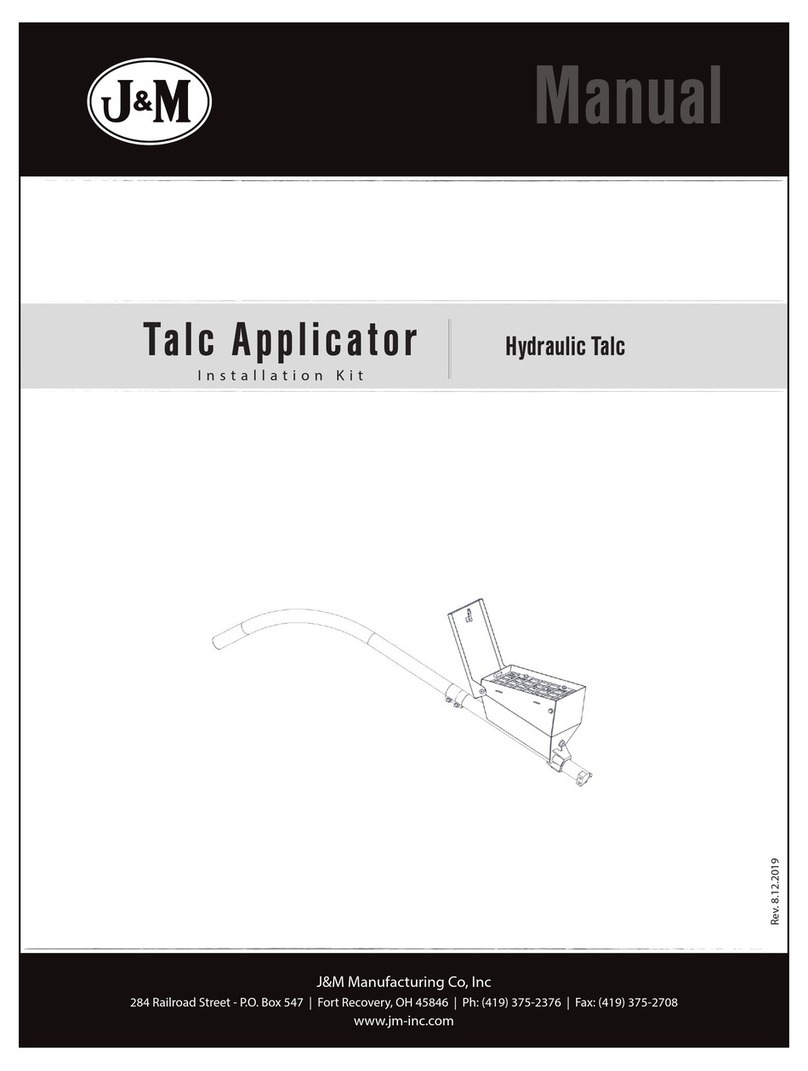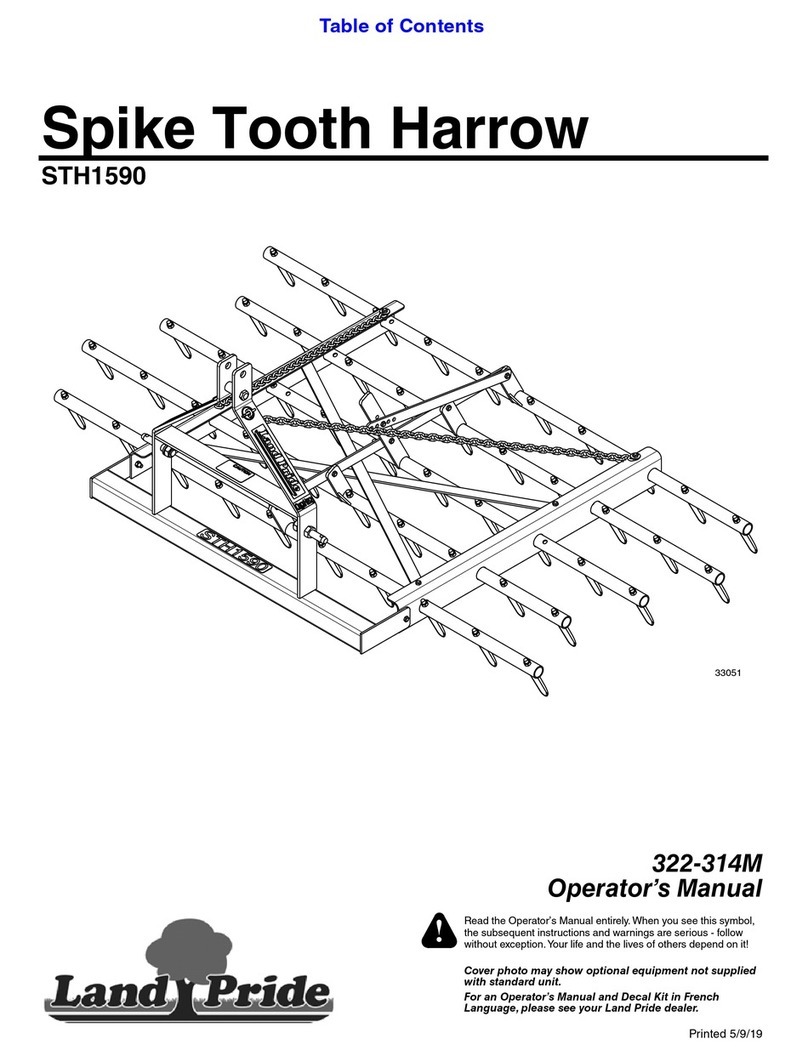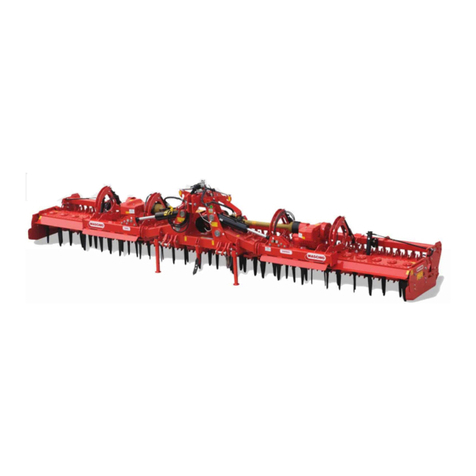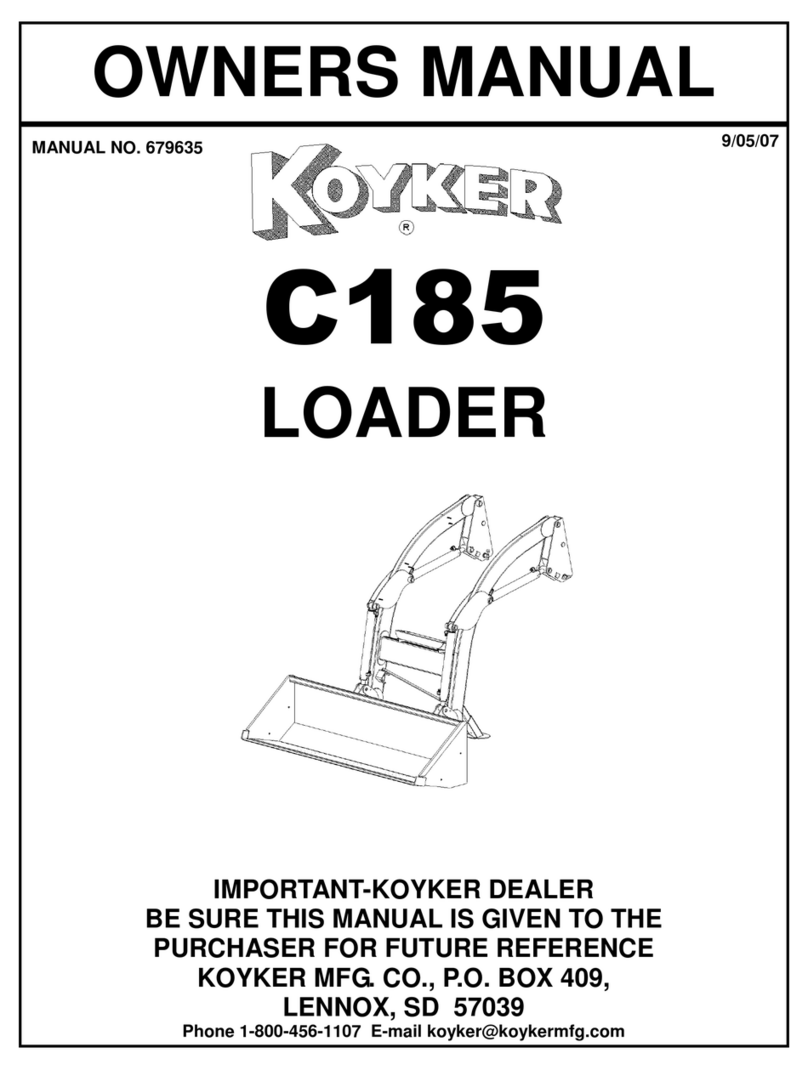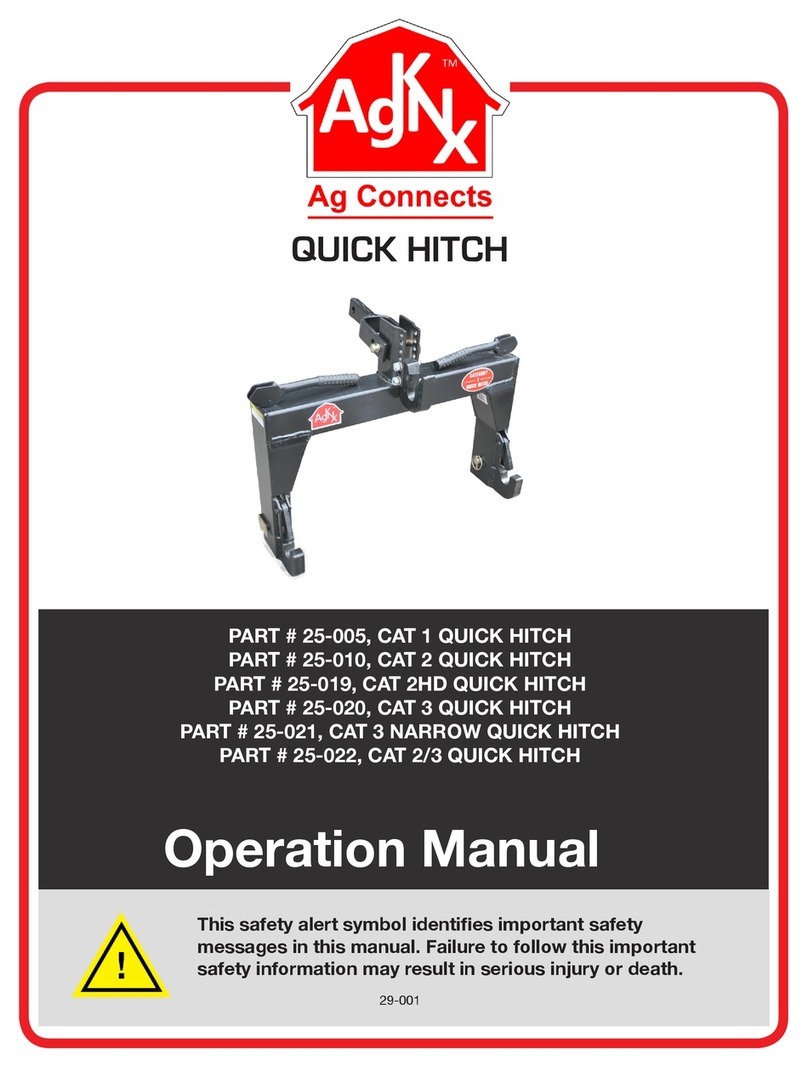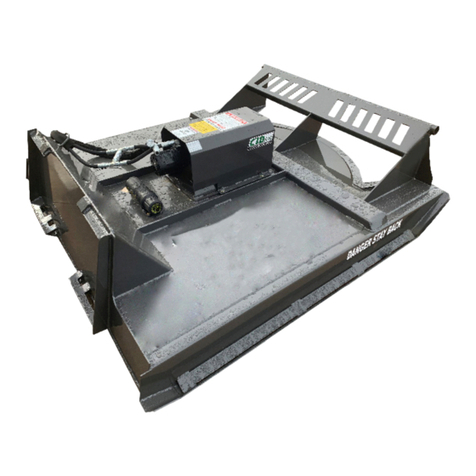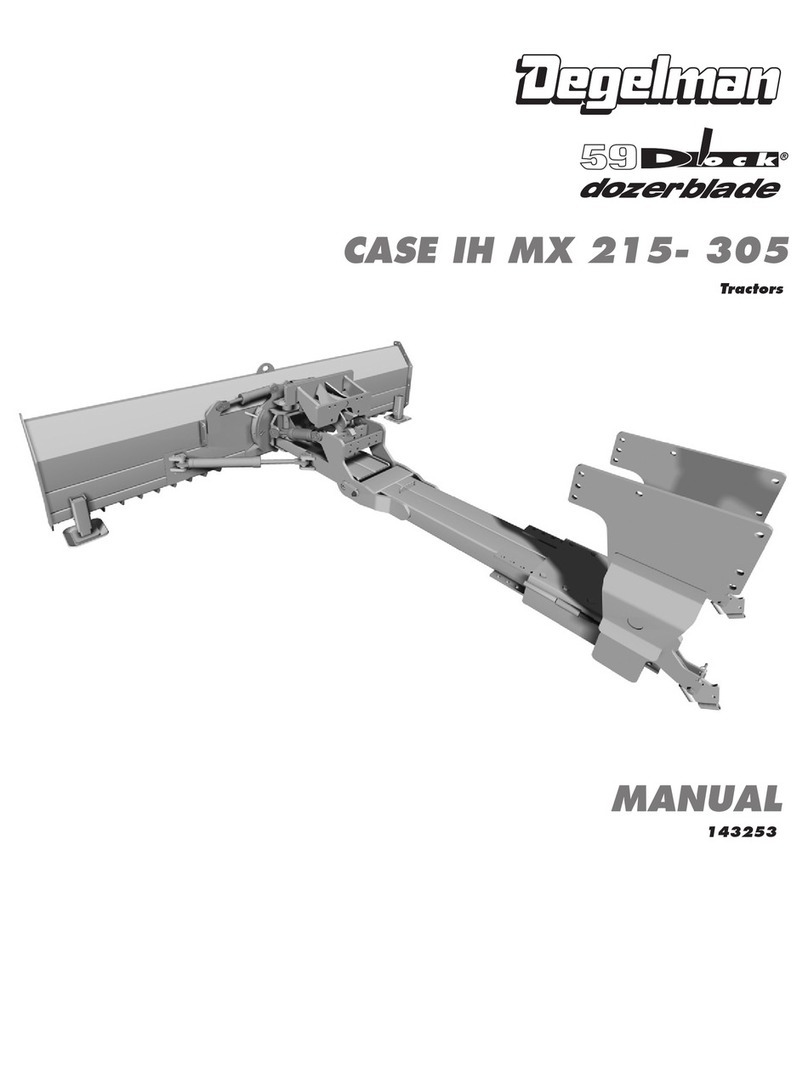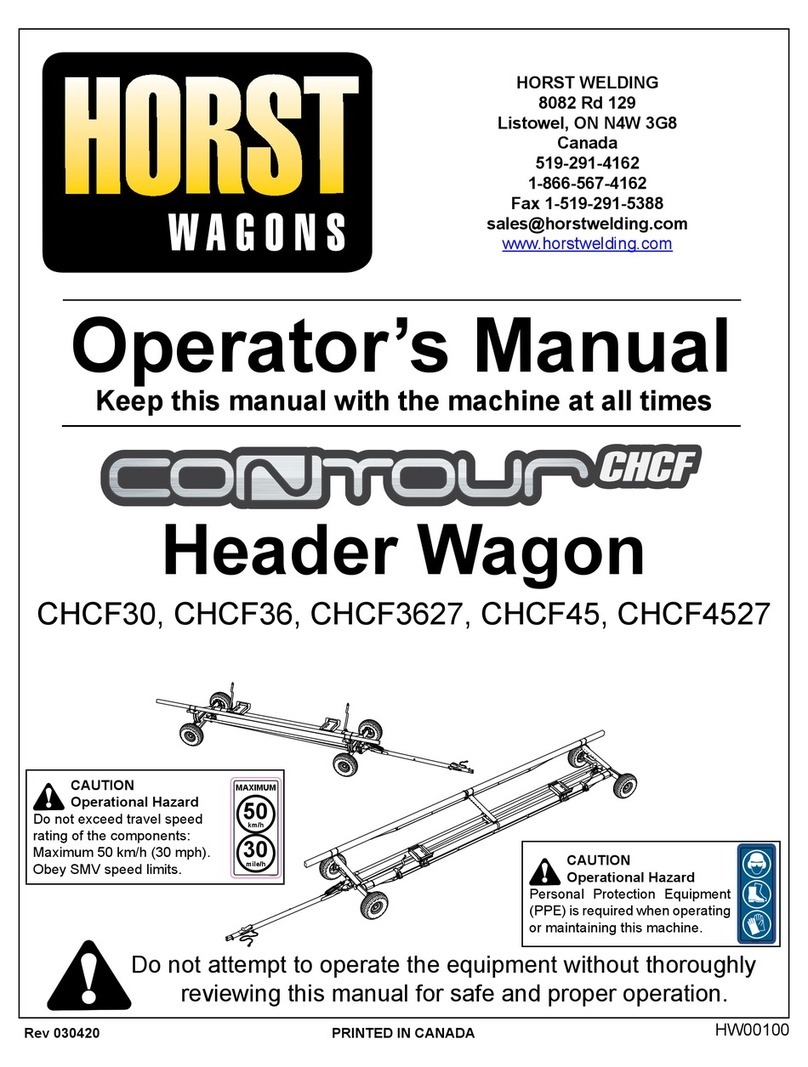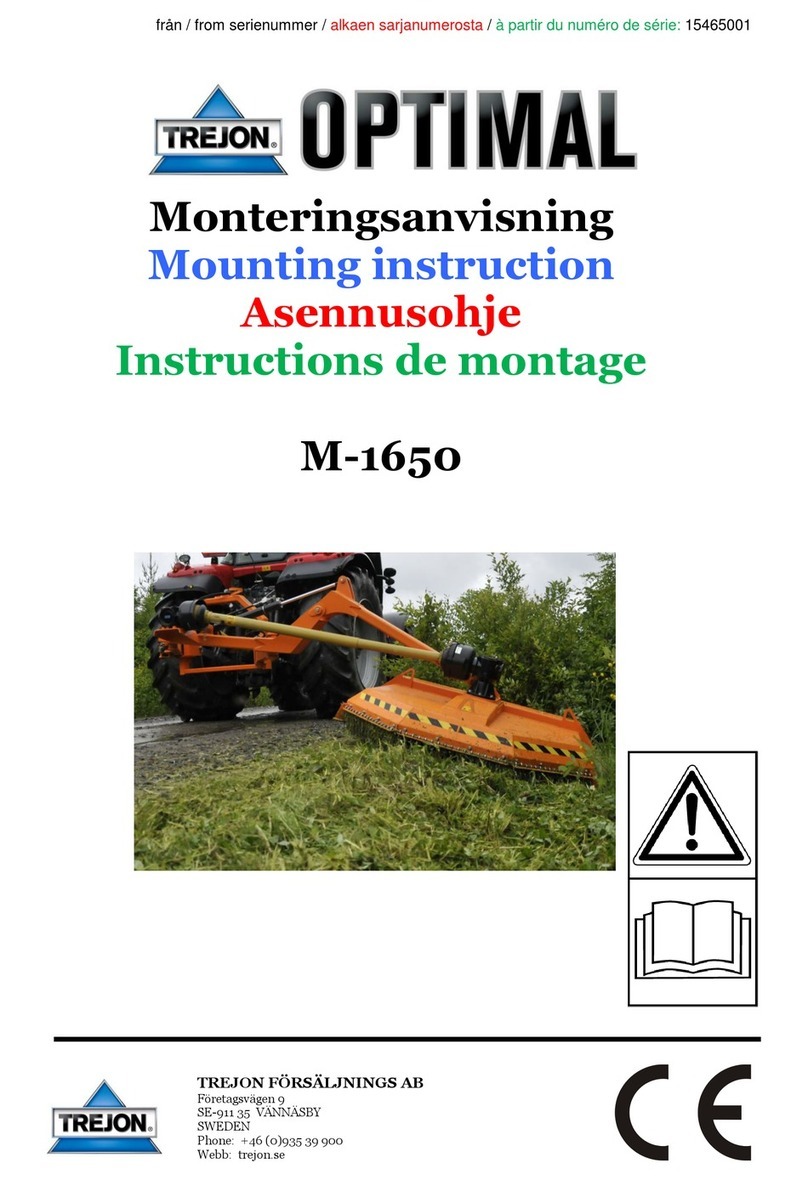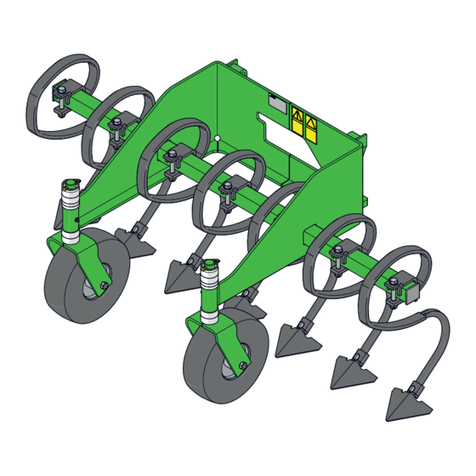GRIBALDI & SALVIA ROTOR R 4 204 User manual

OPERATORS MANUAL
DISC MOWER
MODEL ROTOR


TABLE OF CONTENS
PREFACE
3
SAFETY ALERT SINGS
3
SAFETY INFORMATION & WARNING
4
TECNICAL CHARACTERISTICS
7
ASSEMBLY
8
FRAME
8
PROTECTION
8
STARTING UP
10
FRAME
10
DRIVELINE LENGTH
11
HYDRAULIC HOIST
11
WORKING POSITION
11
CUTTING HEIGHT
12
SAFETY RELEASE
12
BELT TENSION
12
USE
13
DISC AND BLADE SUBSTITUTION
13
MOWER TRANSPORTATION AND STORAGE
14
LUBRICATION
14
BAR
14
TRANSFER CASE
15
DRIVELINE
15
WARNINGS
15
TROUBLE SHOOTING
16


PREFACE
We are delighted to welcome you among our customers and we thank you for choosing our ma-
chine.
Our machines are the result of years of research and experience using the most up to date
technology.
However, for lasting protection of the capital you have invested it is important that you carefully
follow the instructions in this manual which illustrates the characteristics, the operation and the
maintenance of the machine. Particular attention should be paid to safety. The following types of
decals are located on the machine and particular attention should be paid to these alerts:
SAFETY ALERT SIGNS
This symbol identifies important notices in this manual and on decals located
on the machine. When you see this symbol, watch for the possibility of per-
sonal injury. Alwais follow the instructions given in the safety message indi-
cated by this symbol.
CAUTION
This message is used to draw the attention of the operator and surrounding
people to situatious where accidents may occur.
WARNING
This message is used to warn the operator and surrouding people to take
precautions to avoid being involved in an accident by drawing attention to
hidden hazards which could result in serious injury or death.
DANGER
This message is used to warn against dangerous actions which will result in
serious injury or death. This message draws attention to the high risk situa-
tions.
Pag.3

SAFETY INFORMATION &WARNING
WARNING: Alwais read your operators manual thoroughly before oper-
ating or performing any maintenance on your mower. Before you operate
this machine, know your controls and how to stop the tractor and mower
quickly in an emergency! Read and observe all safety decals on the trac-
tor and mower.
Use extreme caution and reduce speed when
operating on hillside. Use cabs equiped with
ROPS (Roll Over Protection) and seat belts.
Mowers are more likely to throw objects when
operating on hillside and tractors can easily
tip. Either could result in serious injury to op-
erator. Never start or stop suddenly when go-
ing up or downhill. This could result in tipping
of the tractor or a roll-over. If steep slopes are
anticipated, adjust the wheel width, add fluid
to tires or add tractor weights to compensate.
Avoid steep slopes. Do not raise the cutter bar
when mowing hillsides. Doing so may in-
crease the likelihood of tipping.
Only the operator should ride on the tractor no
one should ride on the mower. Persons riding
on the tractor or the mower could easily fall
into the path of the machine resulting in seri-
ous injury. Anyone operating this machine
must be instructed in the operation and capa-
ble of safe operation of the unit. Never allow
children to operate this machine!
Never use drugs or alcoholic beverages which
can hinder alertness or coordination while op-
erating. Consult your doctor about operating
this machine while taking prescription drugs.
Always keep all covers, blades and guards,
furnished with the machine, in place and in
good condition. Failure to do so could result in
the operator being struck by high speed cutter
bar. Keep clear all mowing parts.
Make sure all onlookers personnel, children
and pets are out of the area to be mowed.
Make sure pets and small children are not un-
der or around the machine when you start the
mower.
Always wear a hard hat, safety glasses and ear
protection when operating the mower to reduce
the chance of injury from thrown objects and
high noise levels.
Always inspect the area to be cut for foreign
objects or debris before cutting. Failure to do
could result in personnel being struck by loose
objects thrown by rotating blades.
Thrown objects can cause serious injury or
death.
Always wear proper foot protection. Never op-
erate the mower in bare feet or while wearing
sandals or sneakers.
Always operate in daylight conditions or use
sufficient artificial lighting. Use extreme caution
when mowing under conditions which could
hinder yoour ability to see people, pets or ob-
structions in the mowing aerea.
Always check the drive line connections at the
tractor and the gearbox before operation of the
mower. Be sure the quick disconnects are
locked before operation.
Always disengage the tractor PTO and shift into
neutral before starting the tractor.
Never assume that the blades are not rotating
while the tractor is running. Do not place hands
or feet under the mower when the engine is
running.
Always lower the mower to the ground and shut
off the tractor before dismounting and be sure
that the mowing motion has stopped
Failure to do so could result in the operator be-
ing injured by mowing tractor, mower or
driveline parts.
Pag.4

SAFETY INFORMATION & WARNING (Continued)
CAUTION
Never disconnect mower from tractor without cutter bar in the lowered (operating)
position.
Always stop the tractor’s engine and disengage
the PTO before making adjustments or cleaning
the mower.
Always disengage the driveline and block up the machine before
performing maintenance on the mower.
Never operate the mower while in the raised of
the transport position.
Disingage the PTO whenever the mower is in
the transport position.
Avoid sharp turns while mowing.Remenber that
a 3-point mounted mower will swing in a wide
arc when the tractor is turned. Allow sufficient
clearance for the mower when turning.
Always stop the mower and tractor upon hitting
anobstruction.Stop the tractor engine and in-
spect the mower before resuming operation.
When transporting the mower on public roads,
always use the tractor’s safety warning lights
and slow mowing vehicle emblem. Consult local
regulations about the use of additional lights or
flashers.
Perform preventive maintenance on a regular
basis.Replace worn or damaged parts immedi-
ately. Keep all nuts and bolts tight at all times.
Failure to do so could result in serious injury to
personnel or machinery. Make sure all safety
decals are in place and visible.
Replace decals immediately when they become
illegible.
Do not use this machine in extremely rocky
condition
Periodically check the condition of the hydraulic
hoses.Always wear protective eye goggles and
hold a piece of wood on suspected
leaks.Pinhole hydraulic leaks can penetrate
skin.Do not touch.
Never operate the mower with cutter bar locked
in the UP position or any time the cutter bar
locked in the UP position or any time the cutter
bar is raised.Never allow anyone near the cutter
bar when the tractor is running.
Observe minimum and maximum PTO RPM lim-
its.Failure to do so could result in damage to
equipment.Use only 540 RPM.
Always lock the cutter bar in the UP position for
transport, whenever the cutter bar is in the UP
position with no hydraulic pressure on the cutter
bar cylinder or whenever the cylinder is re-
moved. Failure to lock the cutter bar in this posi-
tion could result in the cutter bar falling to the
ground and causing injury.
Never allow children to operate on ride on the
tractor or cutter:
Children 16 years old or older who are large
enough to reach the controls safely, who are
weiltrained and supervised, and who have read
the operations manual and understand the po-
tential hazards are usually capable of operating
the discmower in a reasonable manner.
This mower is of metric design.USE ONLY
METRIC TOOLS. Other wrenches may stip and
cause bodily injury and may ruin the fastener
Pag.5

The following Safety and Informational Decals are located on the
DISC MOWER.
Locate , read and understand these Decals.
Replace any damaged Decals. Keep all Decals clear and readable.
pict. 16
pict. 17
tran-
sport.
working
Pag.6

TECHNICAL CHARACTERISTICS
CHARACTERISTICS
u.m.
R 4
204
R 4
304
R 5
205
R 6
206
R 6
306
R 7
207
WORKING WIDTH
ft.
mt.
5,5’
1,70
1.70
5,5’
1,70
7’
2,05
8’
2,40
8’
2,40
9,5’2
2,80
THEORETIC POWER P/T
hp
30
30
37
43
43
50
NUMBER OF DISCS
n°
4
4
5
6
6
7
BLADES PER DISC
n°
2
3
2
2
3
2
WORKING SPEED
Mp/h
Km/h
12
19
REQUIRED REVS P/T
rpm
500/550
DISC ROTATION SPEED
rpm
3000
YIELD OUT PUT PER HOUR
acre
2.5-4
2.5-4
4-5.5
5.5-7
5.5-7
7-8.5
WORKING POSSIBILITY WITH
INCLINED BAR
yes
SAFETY DEVICE
overrunning clutch release
HYDRAULIC LIFT
yes
DRIVE
“V” belt - gears
INDICATIVE WEIGHT
Kg.
Lb.
345
765
345
765
370
820
400
890
400
890
430
955
He reserve the right to change specifications without prior notice.
Pag.7

ASSEMBLY
FRAME
Attach the chassis to the arm by means of the
pin, and secure this last with the relative plug “A”
(pict. 1).
Connect the hydraulic piston as in (pict. 2), con-
nect the lightening spring Bdevice to the arm and
the end of the piston to the support hose (pict. 3).
PROTECTION
The support hose of the protective element is mounted on the transfer case by means of two M10 screws
and four M12 self-locking nuts “F” (pict. 5).
E
Secure the tip of the release (clutch side) to the frame by means of the relative pin positioning it with
the spring turned outwards “D” (pict. 4), then connect the other tip to the arm inserting it in the relative
pin “E” (pict. 4).
Pict. 2
Pict. 3
Pict. 5
Pict. 4
D
F
Pict. 1
Pag.8
B
C
A

PROTECTION (continued)
Screw the hoist rod to the arm after having removed the
casing cover “A” (pict. 6).
Assemble the safety plastic cover inserting the rod into the
relative eyelet “B” (pict. 7).
Connect the support tube to the ground by means of the
reinforcement arm, using the M10 bolts “C” (pict. 8).
Fix protective frames by M10 screws “D” (pict. 9), and the sheet cover using the tapes supplied “E”
(pict. 10).
The plastic cover is a very important safety feature, it is must therefore be promptly
replaced when it shows signs of wear.
A
B
C
D
E
Pict. 7
Pict. 8
Pict. 9
Pict. 6
Pag.9

STARTING UP
FRAME
Couple the mower to the tractor 3-point link-
age using the pins inside and outside the
frame so as to adapt the machine to the trac-
tor track in the best possible way.
The pins are tapped and can be overturned,
always use the part with the greatest diameter
if possible.
The diagram on the opposite page illustrates
the multiple coupling possibilities (pict. 11-12-
13).
Lift the prop and block it in the working position and secure it with the relative pin “A” (pict 14).
Bring the end of the cable inside the tractor cabin so as to facilitate the release of the bar.
Adjust the stabilizing tie-rods of the tractor so as to position the mower in the most suitable position
“B” (pict. 15).
TECHNICAL CHARACTERISTICS
CHARACTERISTICS
u.m.
R 4
204
R 4
304
R 5
205
R 6
206
R 6
306
R 7
207
WORKING WIDTH
ft.
mt.
5,5’
1,70
1.70
5,5’
1,70
7’
2,05
8’
2,40
8’
2,40
9,5’2
2,80
THEORETIC POWER P/T
hp
30
30
37
43
43
50
NUMBER OF DISCS
n°
4
4
5
6
6
7
BLADES PER DISC
n°
2
3
2
2
3
2
WORKING SPEED
Mp/h
Km/h
12
19
REQUIRED REVS P/T
rpm
500/550
DISC ROTATION SPEED
rpm
3000
YIELD OUT PUT PER HOUR
acre
2.5-4
2.5-4
4-5.5
5.5-7
5.5-7
7-8.5
WORKING POSSIBILITY WITH
INCLINED BAR
yes
SAFETY DEVICE
overrunning clutch release
HYDRAULIC LIFT
yes
DRIVE
“V” belt - gears
INDICATIVE WEIGHT
Kg.
Lb.
345
765
345
765
370
820
400
890
400
890
430
955
He reserve the right to change specifications without prior notice.
pict.11
pict. 13
pict.12
A
pict. 14
pict. 15
B
Pag.10

DRIVELINE LENGTH
Before operating the mower the driveline length must be checked. With the mower attached to
the tractor check the Driveline length as follows.
1) Separate the two halves of the Driveline and connect one half to the Tractor and the other
half to the Mower.
2) Lower the Mower to the operating position.
3) Bring the two Driveline halves together (pict. 16). There should be 1 1/2” (pict.17) or more
clearance from the tubes bottoming out at this maximum compressed length. If necessary
shorten the Driveline to obtain the proper clearance. Do not shorten more than necessary.
Shorten the metal tubes and guards by the same amount and round off all sharp edges and re-
move burr. Grease the metal tubes before assembling.
4) Raise the Mower to the transport position and check the Driveline length at this maximum ex-
tension to make sure the metal tubes are always engaged at least 8 inches (pict.17).
HYDRAULIC HOIST
All the ROTOR mowers are equipped with hydraulic hoist, that operates by means of a single-
action cylinder, therefore it is necessary to use a tractor complete with oleodynamic drive and
distributor, to which the cylinder hose will be connected.
WORKING POSITION
Make sure there are no people or animals
near the machine.
Remove the security latch (A) to lower the
cutting bar (pict. 18).
Pict. 18
Pict. 17
Pict. 16
Pag.11
A

WORKING POSITION (continued)
3) Release the safety hitch bar by means of
the cable and lower the bar until it touches
the ground “A” (pict. 19). By vertically re-
positioning the bar, it will automatically re-
hitch itself.
4) Lower the hoist by about 2”-4” and insert
the hoist command lock in this position.
CUTTING HEIGHT
The cutting height is regulated by the tractor
third-point linkage, which permits the down-
wards lowering of the front part of the bar.
We however advise not to mow too
near the ground in order to avoid the risk of
any blows to the blades by any foreign ob-
jects.
SAFETY RELEASE
The ROTOR mower is equipped with a
safety release element that allows the bar to
rotate backwards in the event of blows.
It is not possible to give an optimum original
calibration due to the diversity of the various
ground conditions, therefore the spring pres-
sure should be regulated by means of the
special self-locking nut (pict. 21).
BELT TENSION
It is important to the check the belt tension especially in the first hours of working. To check the
tension, it is necessary to exert upon each belt a pressure of nearly lb. 8/9 if the flexion is over
1/2“ “A” (pict. 22), proceed as follows:
Pict. 19
Pict. 20
Pict. 21
Pag.12

BELT TENSION (continued)
1) Loosen the two M14 bolts of the pulley support “A” (pict. 23).
2) Stretch the belt by means of the relative M12 screw after having loosened the lock-nut “B”
(pict. 22).
3) Check that the tension is correct and then tighten the M14 bolts “A” (PICT. 23).
When the belts are worn always replace them in complete series (4 belts).
USE
To begin the mowing work, after positioning the bar on the ground, insert the PTO and gradually ac-
celerate until a speed of 540-600 revs per minute is reached.
The loud noise caused by the discs should give no cause for alarm it will be reduced considerably
when the mowing operation begins.
Make sure that the engine does not lose revs during working, as it might cause clogging un-
der the discs.
DISC AND BLADE SUBSTITUTION
The ROTOR mowers are equipped with either oval or triangular discs, these are mounted on the
grooved pin of the pinion in regular sequence so that there is no risk that they knock together. There-
fore in the event of substitution the initial position must be maintained.
The blades are fixed to disc by means of a special block and a M10 screw.
CAUTION: The blades can be of helicoidal shape, in which case the cut will be right and left
and they are to be positioned in relation to the direction of rotation of the disc.
A
B
Pict. 22
Pict. 23
Pict. 24
Pict. 25
Pag.13

MOWER TRANSPORTATION AND STORAGE
Lift the tractor hoist and operate the mower piston, the protective element will fold and the machine
will automatically hitch itself to the safety hook. Shift the pin so as to block the limit device. The
mower is ready for transportation.
For storage, lower the prop, lower the hoist and unhitch the machine from the tractor. Wash the
mower before storing away for the winter, and we recommend that it be positioned with the bar
horizontal to avoid the risk of accidental overturning.
SAE 80W/90 OIL
pict. 26
A
LUBRICATION
The DM 200/300 mowers come supplied with oil. However it is advisable to check the lev-
els; it is necessary to replace the oil after the first 10 hours of work.
BAR
Check and top up with bar in vertical position. The plug is both for filling up and for level
gauge “A” (pict. 26).
DM 204/304 = 3 L.
DM 205 = 3.5 L.
DM 206/306 = 4 L.
DM 207 = 4.5 L.
AS THE PLUG IS MAGNETIC IT MUST BE
THOROUGHLY CLEANED BEFORE
BEING SCREWED BACK.
Pag.14

LUBRICATION (continued)
TRANSFER CASE
Check and top up with the bar in horizontal position. The plug with rod is both for filling up and
for level gauge “A” (pict. 27).
ALL TYPES = 0.3 L. SAE 80W/90
DRIVELINE
Grease Fitting are located on the Cross Assembly of each U Joint and on the Telescoping
Tubes.
Do not force grease through the Needle Cup Assemblies.
Use quality grease to lubricate each part after the number of hours shown in the chart (pict 28).
Consult the shaft operation and maintenance manual.
WARNINGS
Always replace the blades whenever they are damaged so as not to jeop-
ardize the effectiveness of the mowing operation.
Do not continue operations should strange noises or vibrations be felt,
and check the tightening elements.
Carefully read and conserve this manual.
GRIBALDI & SALVIA S.P.A. DECLINES ANY RESPONSIBILITY FOR ANY
ACCIDENTS THAT MIGHT OCCUR AS THE RESULT OF THE IMPROPER
OR INCOMPETENT USE OF THE MACHINE.
A
pict. 27
pict. 28
Pag.15

OPERATION
TROUBLE SHOOTING
TROUBLE
NOT CUTTING CLEAN
STREAKING
NOISY GEARBOX
GEARBOX LEAKING
UNEVEN STUBBLE
STUBBLE TOO LONG
SOIL BUILD UP IN FRONT
OF CUTTERBAR
MOWER BREAKS BACK
TOO EASILY
CAUSE
1. Blades dull.
2. RPM too slow.
3. Ground speed too fast.
4. Incorrect blade rotation
5. Blades locked back
1. Crop too wet.
2. Dull blades.
3. Mud or debris built up be-
tween skid shoes.
1. Rough gears
2. Worn bearing
1. Seal leaking
2. Bent shaft
3. Oil level too high
4. Gasket damaged
5. Bolts loose
1. Too much tilt on cutterbar
2. Slow PTO speed
3. Blades not installed properly
4. Slow disc speed
5. Dull or broken blades
1. Angle on cutter bar incorrect.
1. Wet conditions
2.Too much cutterbar down
pressure
1. Insufficient tension on break
away spring.
REMEDY
-Sharpen or replace.
-Use correct rotation.
-Reduce ground speed.
-Use correct blade for disc
-Free blades
-Allow crop to dry. Slow
ground speed.
-Sharpen or replace blades.
-Clean area between skids.
-Run in or change
-Replace bearing
-Replace seal
-Replace shaft and seal
-Drain oil too proper level
-Replace Gasket
-Tighten bolts
-Reduce tilt
-Operate PTO at 540 RPM
-Check blade installation
-Check belts for correct
tension
-Replace blades
-Change angle using the top
link.
-Allow to dry.
-Reduce cutterbar down
pressure
-Tighten breakaway spring
Pag.16


GRIBALDI & SALVIA S.P.A.
VIA ORCO 43 FR. VESIGNANO
10086 RIVAROLO CANAVESE TO
Tel. 012429046 r.a. Fax 012425862
E-mail: info@gribaldisalvia.com
http://www.gribaldisalvia.com
This manual suits for next models
5
Table of contents
Popular Tractor Accessories manuals by other brands
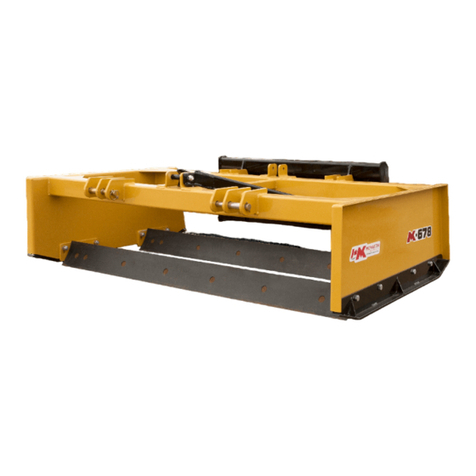
MK Martin
MK Martin MK Series Operator's & parts manual

Homelite
Homelite LM-991013 Instructions-parts list
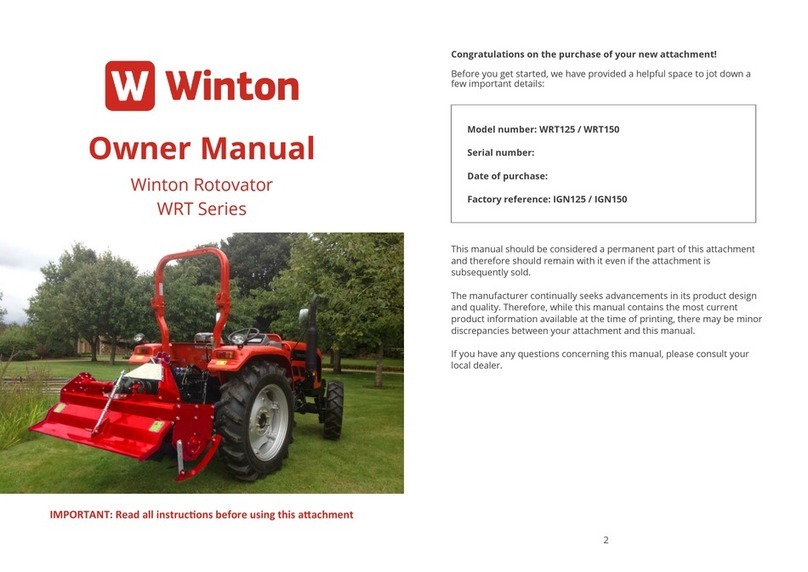
Winton
Winton WRT Series owner's manual

Lipco
Lipco UF 70 TRANSLATION OF ORIGINAL INSTRUCTIONS
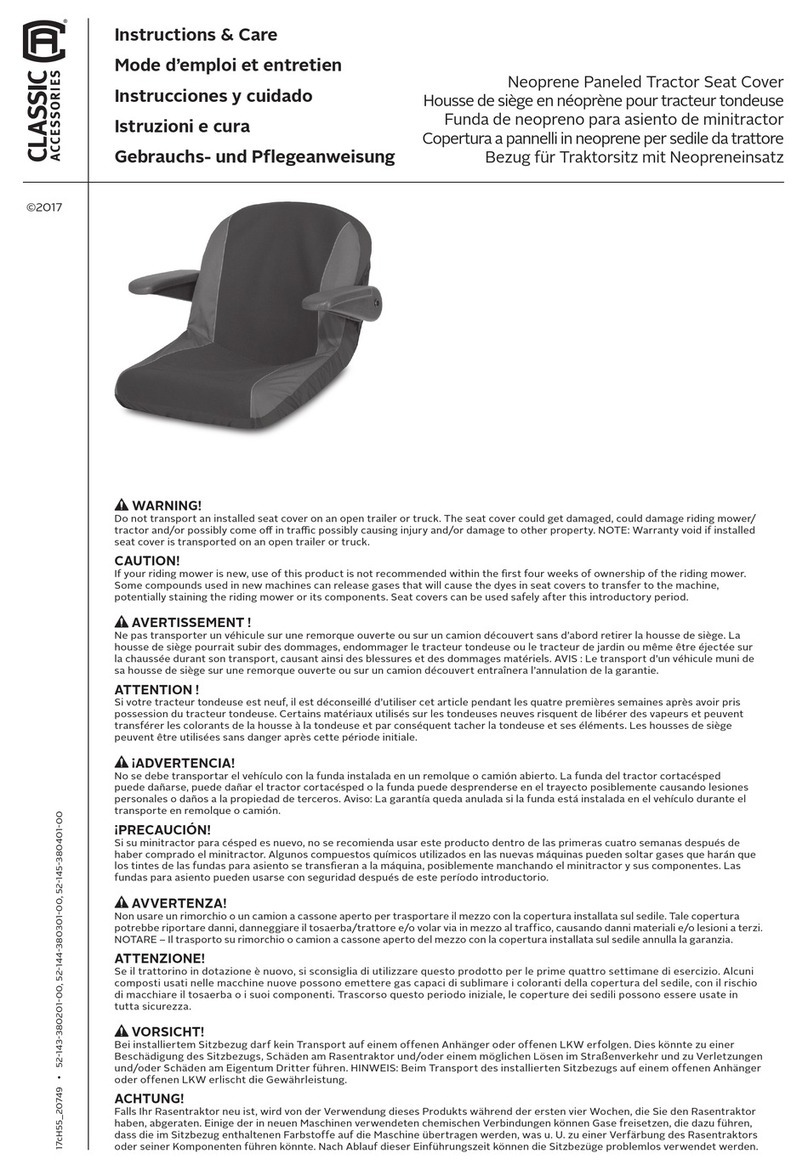
Classic Accessories
Classic Accessories 52-143-380201-00 Instructions & Care
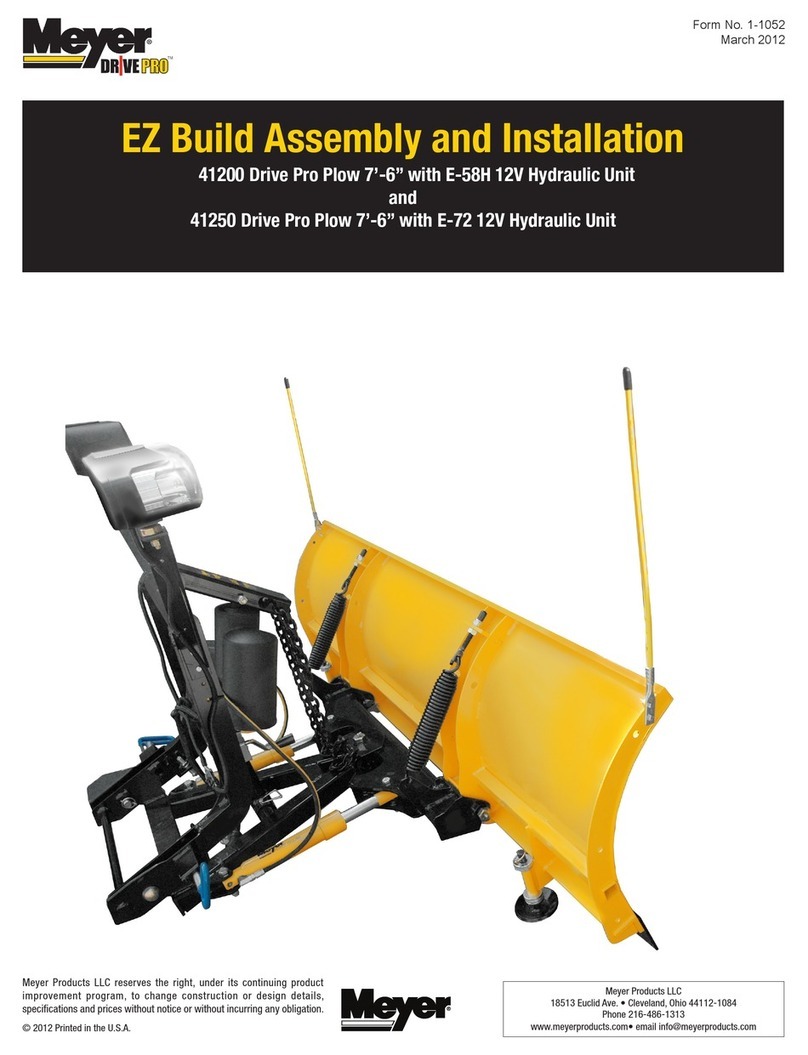
Meyer
Meyer Drive Pro 41200 Assembly and installation
